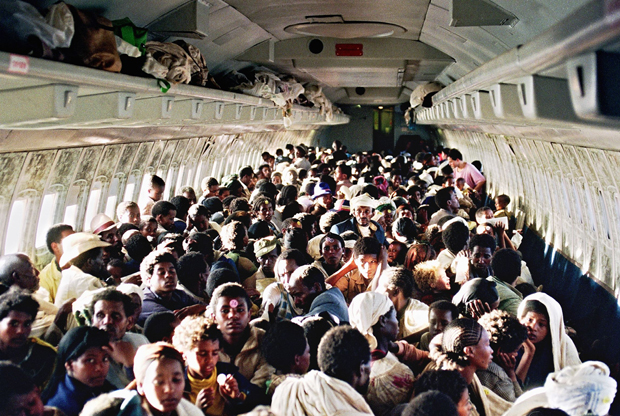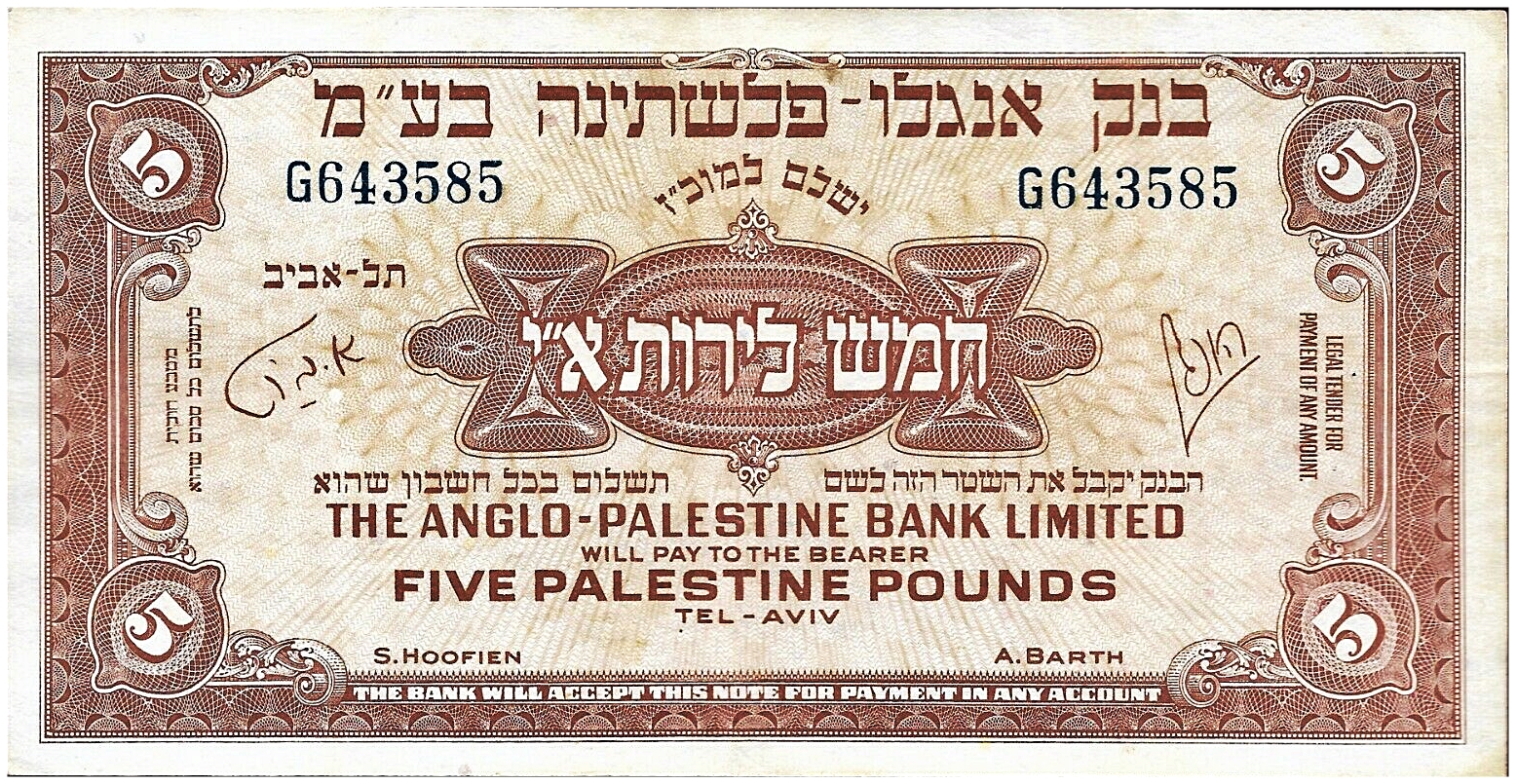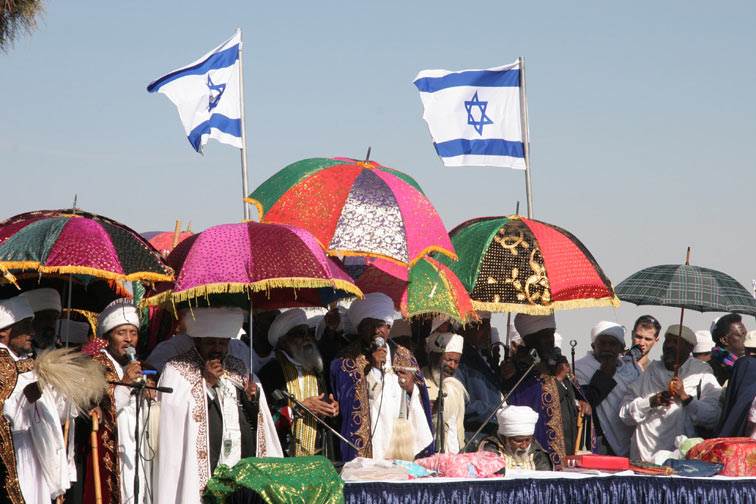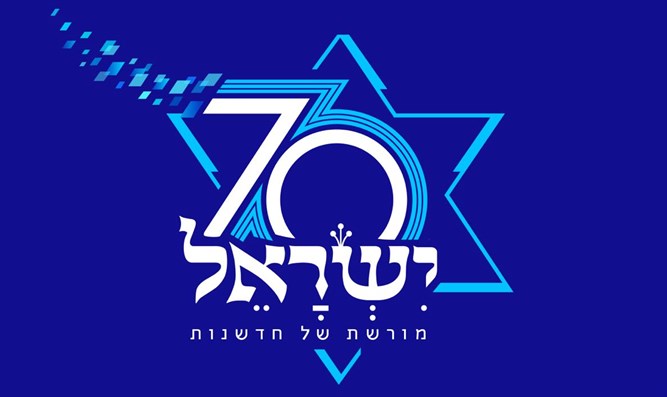 For thousands of years, Ethiopian Jews dreamed about celebrating Sigd in Jerusalem. Finally their dreams have come true. |
Sigd – Holiday of Ethiopian Jewshttps://www.knesset.gov.il/lexicon/eng/sigd_eng.htm Sigd is a holiday of the Ethiopian Jewish community, known as “Beta Israel”. The name of the holiday is derived from the Hebrew word for prostration, “sgida”. During Sigd, which is celebrated on the 29th of the Hebrew month of Heshvan – 50 days after Yom Kippur (similar to the holiday of Shavuot, celebrated 50 days after Passover), the community marks the renewal of the covenant between the Jewish people, God and His Torah. On Sigd, Ethiopian Jews pray to God and plead to return to Zion. The community also holds communal introspection – in addition to the individual self-examination during Yom Kippur – because, according to tradition, in order to be worthy to return to Jerusalem from exile, the public must engage in communal introspection and repentance. Sins of the community members are forgiven during Yom Kippur and the following 50 days. On the 50th day, following communal introspection, the community returns to the Yom Kippur experience with prayers and a fast. Today, since most members of the Ethiopian Jewish community have made Aliyah to the State of Israel, during the holiday members of the community travel to Jerusalem and visit the Wailing Wall and the promenade in the city’s “Armon Hanatziv” neighborhood. The holiday serves as an annual gathering of the entire Ethiopian community, and its members view it as an opportunity to strengthen the connection with their roots and culture. The Kessim (Ethiopian Jewish religious leaders), dressed in their traditional robes, carry the Torah scrolls while holding multi-colored umbrellas. They stand on an elevated stage, read excerpts from the Bible and recite prayers before members of the community, also in Hebrew. Public officials attend the celebration and greet the audience, and many of the community members continue to fast until late in the afternoon. The Knesset legislated the Sigd Law-2008, declaring the 29th of Heshvan as a national holiday. |

Sigd holiday brings thousands to Jerusalem to celebrateTraditional Ethiopian Jewish celebration can help Israeli society ‘ understand that Ethiopian Jews are of the same flesh as all Jews from all over the world.’By JEREMY SHARON NOVEMBER 27, 2019 21:52 https://www.jpost.com/Israel-News/Sigd-holiday-brings-thousands-to-Jerusalem-to-celebrate-609205 Thousands of Ethiopian- Israelis, known as Beta Israel, traveled from across the country to the Haas Promenade facing the Old City of Jerusalem on Wednesday to celebrate the Sigd holiday together with the community’s elders, senior ministers, MKs and the mayor of Jerusalem. Sigd, whose roots are found in the biblical Book of Nehemiah, is marked 50 days after Yom Kippur. Speaking to The Jerusalem Post at the event, Chief Rabbi of the Ethiopian Jewish community in Israel Rabbi Reuven Wabshat said that after the mass immigration of Ethiopian Jews to Israel the decision had been taken by the community to continue to celebrating the holiday, even though its essence is about the yearning to return to Jerusalem. Wabshat said that the decision was made so that the community would not forget the “powerful heritage of Ethiopian Jewry,” and to help Israeli society understand the travails experienced by the Ethiopian Jewish community throughout their history in Africa before their return to Israel. The rabbi asserted that it was crucial for broader Israeli society to understand the Ethiopian Jewish community’s heritage and that it is an integral part of the Jewish people because of the “difficulties” the community has experienced in Israel. The community has frequently complained of discrimination and racism against it, and in particular has suffered from over-policing and a disproportionate number of arrests and indictments relative to its 121,000 members. The recent death of Solomon Tekah following an altercation between a group of youths and a police officer led to renewed claims of police brutality, as well as protests and riots by members of the Ethiopian community. >A previous bout of protests was sparked when video footage emerged of police officers beating an IDF soldier from the Ethiopian Jewish community. “As you know, in recent years, the Ethiopian Jewish community has had difficult experiences, because people do not know and do not appreciate what Ethiopian Jews went through, and looked at things which are not relevant such as differences in place of origin, but not the internal aspects of Ethiopian Jewry,” said Wabshat. “The Sigd holiday can bring people to the understanding and recognition that Ethiopian Jews are of the same flesh as all Jews around the world, and when the state recognizes Sigd, as it has, it means that we can all be one people.” Among the kessim (spiritual leaders) who participated in the prayers was Kes Mentasnut Govze from Beersheba. He explained to the Post how in Ethiopia the Jewish community would travel to and ascend a mountain on Sigd to “pray to God as one people with one heart that we would reach Jerusalem the next year and that the Temple would be rebuilt.” Govze noted that although the community has now reached Israel and Jerusalem, the Jewish people’s mission is not yet finished. “We still have not built the Temple and we must be clean. If we go on the correct path, the path of the Torah, God will help us, we will build the Temple and bring the sacrifices,” said the kes. MK Pnina Tamano-Shata described the holiday as “a big gift for Israeli society” since, she said, it could help unite the Jewish people. “It is so wonderful to see so many people here who are not from the Ethiopian community, and this holiday has become a holiday for all the Jewish people,” said Tamano-Shata. “It is celebrated in kindergartens, schools, in the army, in local authorities, and the message is that this story is your story, it’s my story, and the story of all Jews, whether from Europe or from Arab countries.” The MK said that the identity of the Ethiopian Jewish community was strong, but noted the problems it has faced including “difficulties which are connected to Israeli society such as police violence, discrimination, and racism,” but said that the community remained positive. “We are positive and fully open to Israeli society, we are not in a place of antagonism even though we have had a very hard, challenging, and intensive year, and we are far from getting justice, nevertheless everything has its time and period,” she said. >Michal Avera Samuel, director of the NGO Fidel, said that the thousands of people who came to the celebrations in Jerusalem came “to learn and understand the heritage of Ethiopian Jews which is an ancient heritage which every child should be proud of and pass on to the next generation.” Our goal in Fidel is to promote this platform so the youth can teach those from the Ethiopian community and broader Israeli society. Continued Avera Samuel “The goal is that through studying in school and and youth groups, we can teach the heritage of Ethiopian Jews and build a courageous identity together with a sense of belonging within Israeli society.” |

Operation SolomonFrom Wikipedia, the free encyclopedia https://en.wikipedia.org/wiki/Operation_Solomon Operation Solomon (Hebrew: מבצע שלמה, Mivtza Shlomo) was a covert Israeli military operation to airlift Ethiopian Jews to Israel from May 24 to May 25, 1991. Non-stop flights of 35 Israeli aircraft, including Israeli Air Force C-130s and El Al Boeing 747s, transported 14,325 Ethiopian Jews to Israel in 36 hours.[1]  Operation Solomon:The operation set a world record for single-flight passenger load on May 24, 1991, when an El Al 747 carried 1,122 passengers to Israel (1,087 passengers were registered, but dozens of children hid in their mothers’ robes).
HistoryOperation Solomon was the third Aliyah mission from Ethiopia to Israel. Before Operation Solomon, there was Operation Moses and Operation Joshua, which were two of the other ways that Ethiopian Jews could leave before they were forced to put an end to these type of programs. In between the time when these operations came to an end and Operation Solomon began, a very small number of Ethiopian Jews were able to leave and go to Israel.[2] In 1991, the sitting Ethiopian government of Mengistu Haile Mariam was close to being toppled with the military successes of Eritrean and Tigrean rebels, threatening Ethiopia with dangerous political destabilization. World Jewish organizations, such as the American Association for Ethiopian Jews (AAEJ), and Israel were concerned about the well-being of the Ethiopian Jews, known as Beta Israel, residing in Ethiopia. The majority of them were living in the Gondar region of the Ethiopian Highlands and were mostly farmers and artisans.[3] Also, the Mengistu regime had made mass emigration difficult for Beta Israel, and the regime’s dwindling power presented an opportunity for those wanting to emigrate to Israel. In 1990, the Israeli government and Israeli Defense Forces, aware of Ethiopia’s worsening political situation, made covert plans to airlift the Jews to Israel. America became involved in the planning of Operation Solomon after it was brought to the US government’s attention from American Jewish leaders from the American Association for Ethiopian Jews that the Ethiopian Jews were living in danger. [4] The American government was also involved in the organization of the airlift. The decision of the Ethiopian government to allow all the Falshas to leave the country at once was largely motivated by a letter from President George H. W. Bush, who had some involvement with Operations Joshua and Moses. [4] Previous to this, Mengistu intended to allow emigration only in exchange for weaponry.[1] Also involved in the Israeli and Ethiopian governments’ attempts to facilitate the operation was a group of American diplomats led by Senator Rudy Boschwitz, including Irvin Hicks, a Deputy Assistant Secretary of State for African Affairs; Robert Frasure, the Director of the African Affairs at the White House National Security Council; and Robert Houdek the Chargé d’Affaires of the United States Embassy in Addis Ababa. Boschwitz had been sent as a special emissary of President Bush, and he and his team met with the government of Ethiopia to aid Israel in the arranging of the airlift. In addition, Assistant Secretary of State for African Affairs Herman Cohen also played an important role, as he was the international mediator of the civil war in Ethiopia.[5] Cohen struck a deal with Mengistu that as long as Ethiopians would have an understanding with the rebels, change their human rights and emigration policy and change their communist economic practice.[4] In response to the efforts of the diplomats, acting President of Ethiopia Tesfaye Gebre-Kidan made the ultimate decision to allow the airlift.[6] The negotiations surrounding the operation led to the eventual London roundtable discussions, which established a joint declaration by the Ethiopian combatants who then agreed to organize a conference to select a transitional government.[5] $35 million was raised by the Jewish community to give to the government in Ethiopia so that the Jews could come over to Israel. The money went to the airport expenses in Addis Ababa.[7] OperationThe operation was overseen by the Prime Minister at the time, Yitzhak Shamir.[3] It was kept secret by military censorship.[1] Operation Solomon was sped up with tremendous help from the AAEJ. In 1989, the AAEJ accelerated the process of the Aliyah because Ethiopian-Israeli relations were in the right place. Susan Pollack, who was the director of the AAEJ in Addis Ababa, fought for Operation Solomon to happen sooner rather than later. Israel, who had a gradual plan for this operation, and the US were given a graphic report from Pollack that informed both countries of the terrible conditions that the Ethiopian Jews were living in.[4] The organization went right ahead and got transportation like buses and trucks to have the people of Gondar quickly come to Addis Ababa.[3] To get the Jews in Addis Ababa, many of the Jews that came from Gondar had to venture hundreds of miles by car, horses, and by foot.[12] Some had things taken by thieves on the way, and some were even killed. By December 1989, around 2,000 Ethiopian Jews made their way by foot from their village in the Gondar highlands to the capital and many more came to join them by 1991.[4] In order to accommodate as many people as possible, airplanes were stripped of their seats, and up to 1,122 passengers were boarded on a single plane. May 24, 1991, also happened to be a Friday which falls on Shabbat for Jews.[13] On Shabbat, the Jewish Sabbath, transportation is not used. This made it easier to complete the operation. The Jewish Religious Law mentions that one can break the Sabbath traditions if it is for saving lives.[14] Many of the immigrants came with nothing except their clothes and cooking instruments, and were met by ambulances, with 140 frail passengers receiving medical care on the tarmac. Several pregnant women gave birth on the plane, and they and their babies were rushed to the hospital.[15] Before Operation Solomon took place, many of the Jews there were at a high risk of infection from diseases, especially HIV. The Jews that were left behind had an even higher risk at the infection because the rate of it kept increasing.[4] After a few months, around 20,000 Jews had made their way over. While they were there, they were struggling for basic resources like food and warmth. They thought they would see their families right away.[3] Upon arrival, the passengers cheered and rejoiced. Twenty-nine-year-old Mukat Abag said, “We didn’t bring any of our clothes, we didn’t bring any of our things, but we are very glad to be here.”[1] Operation Solomon airlifted almost twice as many Ethiopian Jews to Israel as Operation Moses. The operation set a world record for single-flight passenger load on May 24, 1991, when an El Al 747 carried 1,122 passengers to Israel (1,087 passengers were registered, but dozens of children hid in their mothers’ robes). “Planners expected to fill the aircraft with 760 passengers. Because the passengers were so light, many more were squeezed in.”[16] Five babies were born aboard the planes.[1] Between 1990 and 1999, over 39,000 Ethiopian Jews entered Israel.[2] |
“Journey to the Promised Land” 1991 – Operation Solomon |
This Soldier Serves On The Same Plane That Rescued Her Family |
-
Today19/04/2024 – י״א בניסן ה׳תשפ״ד
-
Please note that this website uses cookies. Continued browsing of the site constitutes consent to this use.
For more information, see the Privacy Policy.לידיעתך, באתר זה נעשה שימוש בקבצי Cookies. המשך גלישה באתר מהווה הסכמה לשימוש זה.
למידע נוסף ניתן לעיין במדיניות הפרטיותWe recommend you turn off your Ad Blocker.
WE DO NOT ADVERTISE ON THIS SITE.
We do run widgets on the side panel.Jewish Agency Toll Free Phone Numbers

Nefesh B’Nefesh: Live the Dream US & CAN 1-866-4-ALIYAH | UK 020-8150-6690 or 0800-085-2105 | Israel 02-659-5800 https://www.nbn.org.il/ info@nbn.org.il
Nefesh B’Nefesh: Live the Dream
US & CAN 1-866-4-ALIYAH | UK 0800 075 7200 | Israel 02-659-5800 www.nbn.org.il
Grocery Shopping in Israel
English, Hebrew transliterated guide with Meat Chart and Oven Temperatures °F to °C
OCTOBER 7TH POSTS
- 7October
- Am Ysroel Chai עם ישראל חי
- ISRAEL AT WAR 5784: 1 sheep and 70 wolves
- Propaganda vs Reality
- UN, UNRWA and Terror
- You vowed ‘Never Again’
- Prayer for the People of Israel During War
- WAR: Hamas missiles on Jerusalem on Shabbat/Shemini Atzeret 5784
- Never Forget, Never Forgive
- Sanctions
- 100th anniversary of the San Remo Conference
CORONAVIRUS POSTS
- Truth or Consequences Covid-19: The Truth
- They Suffered Myocarditis After COVID-19 Vaccination. Years Later, Some Still Haven’t Recovered
- Watchdog: COVID-19 Vaccines Revealed as ‘Neither Safe, Nor Effective’
- Israeli MOH is hiding a study showing a 2-4 times higher rate of adverse events reports following Pfizer COVID vaccine in kids aged 5-11 vs ages 12-17
- Pfizer-Funded Study Shows Poor Effectiveness for COVID-19 Vaccine in Young Children
- Truth or Consequences Covid-19: More Consequences
- Truth or Consequences Covid-19: The Consequences
- Truth or Consequences Covid-19: More Truth
- Truth or Consequences Covid-19: Save the Children
- Truth or Consequences Covid-19: The Grim Reaper Edition
- Truth or Consequences Covid-19
- Coronavirus COVID-19 Vaccine: Bill Gates “Another Final Solution”
- Coronavirus COVID-19 in the US
- Coronavirus COVID-19 in Israel
- Be Prepared and Stay Healthy
- Wuhan Coronavirus COVID-19 in China
- Bill Gates and the Rockefeller Foundation “Another Final Solution”
GLOBALISM POSTS and Ukraine Posts
- Colour Revolution in Israel
- BRICS
- Buy Locally
- Winter is coming
- Military biological activities of the United States in Ukraine
- News Ukraine Adar 5782
- klopse western
- The Weather report 1 Adar II-5782
- The prophecies are true
- Russia’s Military Operation
- Donbass: Azov Nazi Ukraine Terror
- UKRAINE: DONBASS. YESTERDAY, TODAY, AND TOMORROW
- BURNT ALIVE IN ODESSA. Documentary | 2May2014 Odessa, Ukraine firebombed by Nationalist
- The Dreizin Report – 2022-05-17 – The Fall of the Azov
- Fast Forward to Fascism [Ukraine today]
- Here’s what the Azov Battalion tattoos are hiding
- Interview with a Stormtrooper
- The Azov Battalion: Laboratory of Nazism
“BDS is an anti-Semitic campaign led by supporters of terror with one purpose: the elimination of the Jewish state.” Download the report MSA-report-Behind-the-Mask
Help support a needy Tzadik
Help support Jerusalem Cats

Ministry Of Strategic Affairs Report On “Terrorists In Suits” https://4il.org.il Click to Download the Report.
Click to Enlarge
Uncensored News from Israel and the World
Why Do All These Rabbis Warn Against Getting the Covid-19 Vaccine?
PRAYER TO BE SAVED FROM CORONAVIRUS
Master of Universe, who can do anything!
Cure me and the whole world of the Coronavirus, because redemption is near.
And through this reveal to us the 50th gate of holiness, the secret of the ibbur, and may we begin from this day onward to be strong in keeping interpersonal commandments (i.e. being kind to others).
And by virtue of this may we witness miracles and wonders the likes of which haven’t been since the creation of the world. And may there be sweetening of judgments for the entire world, to all mankind, men women and children.
Please God! Please cure Coronavirus all over the world, as it says about Miriam the prophetess, “Lord, please, cure her, please.”
Please God! Who can do anything! Send a complete healing to the entire world! To all men, women, children, boys and girls, to all humanity wherever they may be, and to all the animals, birds, and creatures. All should be cured from this disease in the blink of an eye, and no trace of the disease should remain.
And all will merit fear of Heaven and fear of God, O Merciful and Compassionate Father.
Please God, please do with us miracles and wonders as you did with our forefathers by the exodus from Egypt. And now, take us and the entire world out from this disease, release us and save us from the Coronavirus that wants to eliminate all mortals.
We now regret all the sins that we did, and we honestly ask for forgiveness. And in the merit of our repentance, this cursed disease, that does not miss men, women, boys, girls, and animals, will be eliminated.
Please God, as quick as the illness came it will go away and disappear immediately, in the blink of an eye, and by this the soul of Messiah Ben David will be revealed.
Please God, grant us the merit to be included in the level of the saints and pure ones, and bless anew all the fruit and vegetation, that all will be healed in the blink of an eye, and we will see Messiah Ben David face to face.
Please God, who acts with greatness beyond comprehension, and does wonders without number. Please now perform also with us miracles and wonders beyond comprehension and let no trace of this cursed disease remain. And may the entire world be cured in the blink of an eye.
Because Hashem did all this in order for us to repent, it is all in order for us to direct our hearts to our Father in Heaven, and by that He will send blessings and success to all of our handiwork.
Important Posts
-
Bill Gates and the Rockefeller Foundation: Vaccine News
-
After Monsey, and New York – Kristallnacht!
- How to help YOUR Relatives Escape from New York
-
A Portrait of Jewish Americans
-
The Jewish People Policy Institute-Raising Jewish Children 2017
- Jonathan Pollard
- We have no other country – אין לנו ארץ אחרת
- You are a Princess
- Modesty for Women – Wig Vs Scarf
-
BDS Know the Facts
- CAMERA: Quantifying the Israeli-Palestinian Conflict’s Importance to Middle East Turmoil
- Warnings to American Jews
- A response to the EU Boycott of Yesha Israel
- Israel is not America
- A School is connected to a Congregation or a Rabbi, Who are they?
- Another reason to use a good Kosher certification hecksher
- Health Risks of Genetically Modified Food or The benefits of keeping Kosher
- What’s in Your Milk? 20+ Painkillers, Antibiotics, and More
- Cholov Yisroel: Does a Neshama Good
- Cell Phones:The Day Einstein Feared Has Arrived
- Death in Advertising – Coke and Cigarettes
- College life in America
- 1 sheep and 70 wolves-Hanukah Geography
- A Heart to Heart talk about Christian missionaries and Jewish Assimilation
- Anatomy of a smear
- Remembering the hard times predating the startup nation
-
Israel: The World’s First Modern Indigenous State
- Rosh Hashanah Foods
- How to assemble an Israeli Succah
-
Hanukkah Posts and Recipes
- 1 January is Sylvester Day יום סילבסטר
- Tu B’Shevat-How and What to check for Bugs
- How to Celebrate Purim
- Purim for Cats: Purim behind the Scenes
- The Day After Purim-How to Prepare for Pesach
- Pesach Tips and Schedule
- Preparing for Pesach
- Sell your Chametz online:
- Pesach Wonder Pot סיר פלא Recipes
- Pesach and Beyond פסח ומעבר
- La Haggada De L’idee Juive
- Counting The Omer ספירת העומר
- Shlissel or Key Challah
- YOM HASHOAH יום שואה
- Yom Hazikaron : יום זיכרון We Remember and Honor our fallen
- Yom HaAtzma’ut- יום העצמאות
-
Shavot Wonder Pot סיר פלא Recipe-Cheesecake
- Tisha B’Av 2013 תשעה באב תשע”ג
- Tisha B’AV Love your fellow Jew

הסערה הבאה שרת התרבות מירי רגב הורתה להכניס ללוגו הרשמי של חגיגות היובל לאיחוד ירושלים את המילה שחרור ירושלים במקום איחוד העיר
נשלח על ידי
איתמר אייכנר
אחרי
Jewish Agency Toll Free Phone Numbers
Nefesh B’Nefesh: Live the Dream
US & CAN 1-866-4-ALIYAH | UK 0800 075 7200 | Israel 02-659-5800 www. nbn.org.il
Alyah : mode d’emploi http://www.jewishagency.org/fr/aliyah/program/7618
Choisissez celle qui vous correspond et inscrivez-vous sur notre site Internet en cliquant ICI ou par téléphone, en appelant le Global Center au 0800 916 647
The Jewish Agency Global Service Center http://www.jewishagency.org/global_centerUS 1-866-835-0430 | UK 0-800-404-8984 | Canada 1-866-421-8912
The Jewish Agency Global Service Center
Point of No Return: Jewish Refugees from Arab Countries
From the 1940s until the 1970s, and heightening with the founding of Israel in 1948, nearly million Jews were expelled from their homes across Arab countries such as Iraq, Syria, Lebanon, Egypt, Yemen, Libya, Algeria and Iran.
Jews were frequently subjected to pogroms, systemic violence and religious persecution. Their exiles were largely attributable to Arab regimes increasing their hostility toward Jews because of the very existence of Israel.
Today, while stories abound of many Arab refugees, few are aware or even acknowledge this forgotten exodus of Jewish refugees. Only in Israel has Nov. 30, the day after the UN voted to approve the Jewish-Arab partition plan of Palestine, been marked to commemorate their plight.
Inspirational Breslev teachings in emunah, bitachon and hitbodedut- today!
Breslov Shiurim Podcasts
Subscribe to Podcasts on RSS, iTunes or Poddirectory

Podcasting Help Five Best Podcast ManagersRav Nasan Maimon | Breslov Torah | Free Listening on SoundCloudRabbiisrael on Sound Cloud

The Canary Mission database was created to expose individuals and groups that are anti-Freedom, anti-American and anti-Semitic in order to protect the public and our democratic values.
1948 Jewish 5 Palestine Pounds Note

Issuer Israel
Issuing bank Anglo-Palestine Bank Limited
Period State of Israel (1948-date)
Type Standard banknote
Years 1948-1952
Value 5 Palestine Pounds
Currency Palestine Pound (1948-1949)
Composition Paper
Size 105 × 68 mm
Shape Rectangular
Demonetized 23 June 1952
Number N# 207999
References P# 16 April 2024 S M T W T F S 1 2 3 4 5 6 7 8 9 10 11 12 13 14 15 16 17 18 19 20 21 22 23 24 25 26 27 28 29 30 -
An important piece of evidence: The British Palestine Exploration Fund survey map – 1871-1877 – The PEF people delineated every wadi, every settlement, tree, and home. They crisscrossed the territory, and an examination of the map shows how empty and barren the land was, and how few people lived there.
“The Palestinian people does not exist. The creation of a Palestinian state is only a means for continuing our struggle against the state of Israel for our Arab unity… Only for political and tactical reasons do we speak today about the existence of a Palestinian people… to oppose Zionism.” Zuheir Muhsein, the late Military Department head of the PLO and member of its Executive Council.; March 1977, Dutch daily Trouw
London cab driver’s answer to a request from a Muslim to turn off the radio. (You just got to love the Brits.)
A devout Arab Muslim entered a black cab in London .
He curtly asked the cabbie to turn off the radio because as decreed by his religious teaching, he must not listen to music because in the time of the prophet there was no music, especially Western music which is the music of the infidel.
The cab driver politely switched off the radio, stopped the cab and opened the door.
The Arab Muslim asked him, “What are you doing?”
The cabbie answered, “In the time of the prophet there were no taxis, so get out and wait for a camel.”I wonder how many years (hundreds for sure) Jewish people have lived in Quebec. I don’t believe that they have ever demanded that pork be removed from the school’s menu where their children attend…
Excellent reply by the Mayor of Dorval, Quebec, to the demands of the Muslim population in his community.
Put some pork on your fork.
Too bad the USA doesn’t have the common sense to publish this nationwide, even if they have a muslim in the white house. Should also be posted on signs all along U.S. borders.Let’s hear it for a Quebec mayor.
MAYOR REFUSES TO REMOVE PORK FROM SCHOOL CANTEEN MENU. EXPLAINS WHY
Muslim parents demanded the abolition of pork in all the school canteens of a Montreal suburb. The mayor of the Montreal suburb of Dorval, has refused, and the town clerk sent a note to all parents to explain why..
“Muslims must understand that they have to adapt to Canada and Quebec, its customs, its traditions, its way of life, because that’s where they chose to immigrate.
“They must understand that they have to integrate and learn to live in Quebec .
“They must understand that it is for them to change their lifestyle, not the Canadians who so generously welcomed them.
“They must understand that Canadians are neither racist nor xenophobic, they accepted many immigrants before Muslims (whereas the reverse is not true, in that Muslim states do not accept non-Muslim immigrants).
“That no more than other nations, Canadians are not willing to give up their identity, their culture.
“And if Canada is a land of welcome, it’s not the Mayor of Dorval who welcomes foreigners, but the Canadian-Quebecois people as a whole.
“Finally, they must understand that in Canada ( Quebec ) with its Judeo-Christian roots, Christmas trees, churches and religious festivals, religion must remain in the private domain. The municipality of Dorval was right to refuse any concessions to Islam and Sharia.
“For Muslims who disagree with secularism and do not feel comfortable in Canada, there are 57 beautiful Muslim countries in the world, most of them under-populated and ready to receive them with open halal arms in accordance with Shariah.
“If you left your country for Canada, and not for other Muslim countries, it is because you have considered that life is better in Canada than elsewhere.
“Ask yourself the question, just once, “Why is it better here in Canada than where you come from?”
“A canteen with pork is part of the answer.”
If you feel the same forward it on.
This reminds me of a Morty Dolinsky story from the time he was head of the Government Press Office:
When the late Morty Dolinsky was in charge of the Government Press Office in the 1980s, he once famously replied to a reporter, who asked for information about the West Bank, that he knew no West Bank as he banked at Leumi. -
Archives
-
Pages
- About the Artist, Cookbook & Novels
- Aliyah Tips
- Aliyah, Health & News
- 100 Years After Balfour Declaration, The Arabs Have Failed Where Israel Has Excelled
- Aliyah Outer Limits Archive
- Aliyah Outer Limits News
- CAMERA – BACKGROUNDER: The Intrinsic Antisemitism of BDS
- CAMERA: Quantifying the Israeli-Palestinian Conflict’s Importance to Middle East Turmoil
- Jonathan Pollard
- Mr. Happy Good News
- Mr. Happy’s Aliyah Outer Limits
- Mr. Happy’s Banned Health News
- Mr. Happy’s GMO – Genetically Modified Food News
- Mr. Happy’s Health News
- Mr. Happy’s Nuclear News
- Mr. Happy’s Past Weekly Column
- Mr. Happy’s Weekly Column
- Mr. Happy’s Wellness Page
- Mr. Happy’s World News
- Not in the News
- Other News
- Astrology, Gematria & Recipes
- Breslov
- Cat Quintet and Cat Videos
- Cat Quintet: Aurora – The Andrews Sisters
- Cat Quintet: Beach Boys
- Cat Quintet: Bei Mir Bist Du Schon – The Andrews Sisters
- Cat Quintet: Besame Mucho – Xavier Cugat and His Orchestra
- Cat Quintet: Best Meditation Music – Oliver Shanti
- Cat Quintet: Let’s Call The Whole Thing Off
- Cat Quintet: Steppenwolf – Magic Carpet ride
- Cutest Cat Moments Videos
- Debbie’s Worm
- For a-sweet boy, I will always remember
- Sons of the Pioneers – What this Country Needs
- Sons Of The Pioneers: Dixie
- You Are My Sunshine
-
Ephemeris

Sun in Aries
Moon in Virgo
10 degrees
Waxing Gibbous Moon
10 days old -
Spam Blocked




















